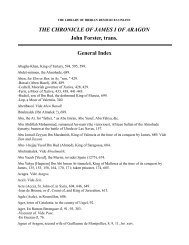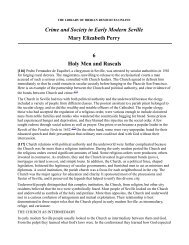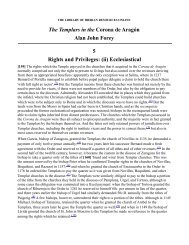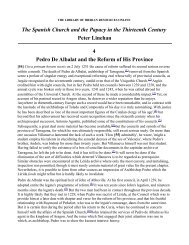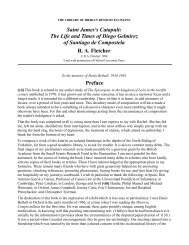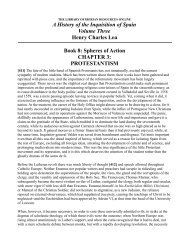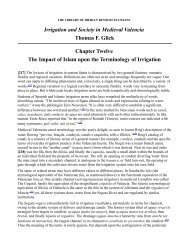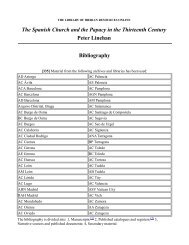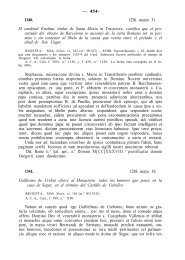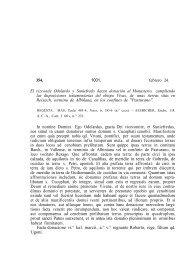The Pactual Tradition in Hispanic Monasticism - The Library of ...
The Pactual Tradition in Hispanic Monasticism - The Library of ...
The Pactual Tradition in Hispanic Monasticism - The Library of ...
Create successful ePaper yourself
Turn your PDF publications into a flip-book with our unique Google optimized e-Paper software.
IV<br />
At this po<strong>in</strong>t, before turn<strong>in</strong>g to the pactualism <strong>of</strong> the Alta Reconquista, there needs to be considered one<br />
largely ignored feature <strong>of</strong> 'Fructuosan' <strong>in</strong>strument <strong>of</strong> the 7th century upon which the comparable<br />
diplomas <strong>of</strong> succeed<strong>in</strong>g centuries throw considerable light. Both RComP and its various more or less<br />
closely related adaptations after 711 have been studied by Herwegen and later students <strong>in</strong> terms <strong>of</strong><br />
strictly monachal acts, addressed by the subditi to their abbot and term<strong>in</strong>at<strong>in</strong>g with their subscriptions.<br />
But what provision did the system make for what would seem to be no less juridically necessary <strong>in</strong> a<br />
bilateral contract, the abbot's own promise to serve under the terms stipulated? Herwegen apparently<br />
assumed that such an abbatial commitment was implicit <strong>in</strong> his texts and therefore never sought to<br />
expla<strong>in</strong> why the abbot's own name normally does not appear among the subscribants to what he saw as<br />
primarily a foundational charter.<br />
This is a difficulty that disappears once we perceive that, by the commencement <strong>of</strong> the 9th century at<br />
least, evidence survives to show that the 'Fructuosan' pactum from the very beg<strong>in</strong>n<strong>in</strong>g actually<br />
consisted <strong>of</strong> not one, but two, dist<strong>in</strong>ct yet <strong>in</strong>separably l<strong>in</strong>ked parts or subpacta: one the well-known<br />
covenant <strong>of</strong> the monks, the pactum monachorum; the other, the abbot's own declaration, a pactum<br />
abbatis or abbatiale. Taken together, both texts constitute what we may call the double, or, preferably,<br />
so as to avoid all confusion with double monasteries and double traditiones , the b<strong>in</strong>ary pactum.<br />
<strong>The</strong> pr<strong>in</strong>cipal characteristics <strong>of</strong> such a comb<strong>in</strong>ed <strong>in</strong>strument can most readily be isolated <strong>in</strong> the early,<br />
exceptionally complete case <strong>of</strong> the Liébanese abbey <strong>of</strong> San Pedro y San Pablo de Naroba, one <strong>of</strong> the<br />
oldest known eastern centers <strong>of</strong> the transplanted Gallegan pactualism <strong>of</strong> the Alta Reconquista. <strong>The</strong><br />
extant pactual preserved from this house was first drawn up <strong>in</strong> 818 and rema<strong>in</strong>ed <strong>in</strong> use through the<br />
terms <strong>of</strong> three successive abbots down to ca. 825-35. An unusually large document <strong>of</strong> some 42.5 x 35<br />
cms., it survives <strong>in</strong> a copy <strong>of</strong> the 12th century, so carefully made <strong>in</strong> a good Visigothic hand as to give<br />
the strong impression <strong>of</strong> be<strong>in</strong>g a faithful, almost [26] photographic, facsimile <strong>of</strong> the lost orig<strong>in</strong>al. (93)<br />
What we have here <strong>in</strong> fact are not merely two but five associated texts, all unknown to Herwegen and<br />
first published <strong>in</strong> 1944 by Sánchez Albornoz and a year later by Pérez de Urbel. Of these only one,<br />
which stands first <strong>in</strong> the series, is the pactum monachorum by which the monks and nuns <strong>of</strong> this double<br />
community promise to observe the ascetic life under the abbot Argilegus; as might be expected <strong>in</strong> such<br />
an act only a century removed from those circulat<strong>in</strong>g <strong>in</strong> the monasteries <strong>of</strong> Visigothic Galicia, this<br />
follows relatively closely the language and provisions <strong>of</strong> RComP , although with certa<strong>in</strong> highly<br />
<strong>in</strong>formative adaptations and omissions.<br />
At the close <strong>of</strong> the monachal pactum the date "sub die pridie kalendas martias discurrente era<br />
DCCCLVI" is carefully recorded; but this is not followed, as might be expected, by the subscriptions <strong>of</strong><br />
the religious. Instead, after a short space, there commences <strong>in</strong> the name <strong>of</strong> the abbot Argilegus a<br />
"confirmatio uel compromissio" by which the community's governor bestows upon it various <strong>of</strong> his<br />
properties. This is to all <strong>in</strong>tents and purposes the abbatial counterpart to the self-submission <strong>of</strong> the<br />
monks, the pactum abbatis under which by implication Argilegus assumes <strong>of</strong>fice <strong>in</strong> accordance with<br />
the stipulations made <strong>in</strong> the monachal pactum; although undated it must have been drawn up at the<br />
same time as the latter. <strong>The</strong>n follows <strong>in</strong> the pergam<strong>in</strong>o a third text, also without date but evidently<br />
issued simultaneously with its two predecessors, which takes the form <strong>of</strong> a donation made "<strong>in</strong> hunc<br />
pacto uel traditione" by the abbot's k<strong>in</strong>sman Sisbertus, who bestows upon Naroba and its religious onefourth<br />
<strong>of</strong> his landed properties and movables. This charter, although confirm<strong>in</strong>g other testimony to the<br />
familial character <strong>of</strong> the structure and primitive endowment <strong>of</strong> the abbey, is <strong>of</strong> secondary <strong>in</strong>terest; more<br />
important is the fact that follow<strong>in</strong>g its eschatocol we f<strong>in</strong>ally reach the subscriptions <strong>of</strong> the twelve<br />
monks and nuns who composed the subter notati <strong>of</strong> the pactum monachorum, each cast <strong>in</strong> the form "<strong>in</strong><br />
hoc pacto manu mea.( Sig.) feci". This term<strong>in</strong>al list <strong>of</strong> names constitutes the bond that ties together the<br />
first and second pieces, the pacta or strictly subpacta , i.e., the two fundamental, <strong>in</strong>separable parts <strong>of</strong>




